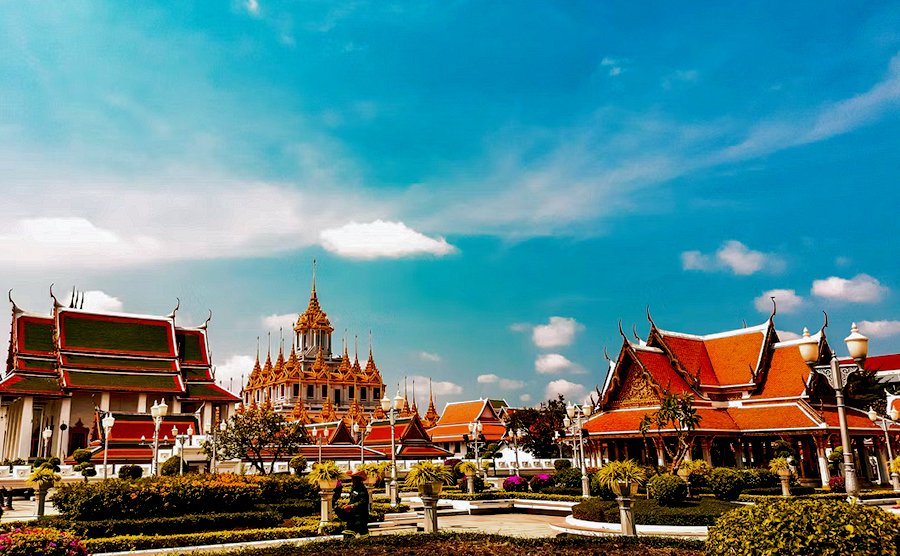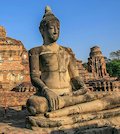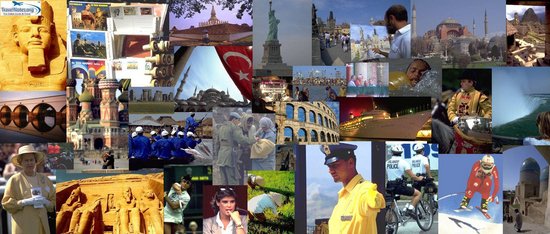Travel Notes: Destinations: Asia: Thailand - Bangkok Travel Guide.
Short URL: https://tnot.es/BKK
Travel Guide For Visitors to Bangkok
Discover top sights, vibrant neighbourhoods, cultural landmarks, and insider tips to make your visit to Bangkok, the capital of Thailand, truly unforgettable. Share on Facebook
Bangkok Delivers Something Special
Whether dodging tuk-tuks through traffic-clogged streets, bargaining at floating markets, or marvelling at golden temples that catch the morning sun, Thailand's capital pulses with an energy that is impossible to ignore.
 Add a Business -
Add a Location -
Add a Lodging - Add Travel Content
- Add URL
- Travel Services.
Add a Business -
Add a Location -
Add a Lodging - Add Travel Content
- Add URL
- Travel Services.
Visiting Bangkok - The Capital of Thailand
This sprawling metropolis manages to blend ancient traditions with modern chaos in ways that shouldn't work but absolutely do.
One moment you're admiring intricate Buddhist architecture that's stood for centuries, the next you're sipping cocktails on a rooftop bar with views across the glittering skyline.
Getting Your Bearings in Bangkok
Getting Around Bangkok
Bangkok's public transport system has improved dramatically in recent years.
The BTS Skytrain connects major shopping areas and tourist spots, whilst the MRTA (Mass Rapid Transit Authority of Thailand) underground system serves different districts.
Both are air-conditioned, efficient, and reasonably priced.
Taxis are plentiful but can get stuck in legendary Bangkok traffic. Always insist on using the meter or agree on a price beforehand.
Grab (South-east Asia's equivalent of Uber) is widely available and often more reliable.
For shorter distances, tuk-tuks provide an authentic Bangkok experience, though they're generally more expensive than taxis and less comfortable.
Motorbike taxis are the quickest way to navigate traffic but aren't recommended for nervous passengers.
When to Visit Bangkok
Bangkok's tropical climate means it's warm year-round, but timing your visit makes a substantial difference.
Cool Season (November to February)
Offers the most comfortable weather, with temperatures hovering around 25-30°C and lower humidity.
This is peak tourist season, so expect crowds and higher prices.
Hot Season (March to May
Sees temperatures soar above 35°C, making outdoor exploration challenging during midday hours.
However, you'll find better deals and fewer crowds.
Rainy Season (June to October)
Brings daily downpours, but they're usually short-lived and provide welcome relief from the heat.
Must-See Bangkok Attractions
Chatuchak Weekend Market
With over 15,000 stalls spread across 35 acres, Chatuchak Weekend Market is a shopper's paradise and cultural experience rolled into one.
You'll find everything from vintage clothing and handcrafted souvenirs to exotic pets and antique furniture.
The market operates Saturday and Sunday from 6am to 6pm, with Friday evenings dedicated to plants and flowers.
Navigate the numbered sections methodically, stay hydrated, and prepare for sensory overload.
Grand Palace and Wat Phra Kaew
The Grand Palace showcases Thai craftsmans' work, as well as Thai royal history, making it Bangkok's most visited attraction.
This sprawling complex served as the royal residence for 150 years and remains the spiritual heart of the Thai kingdom.
The Emerald Buddha (Wat Phra Kaew) within the palace grounds is Thailand's most sacred Buddhist image.
The intricate architecture, golden spires, and detailed murals create a sensory overload that's both overwhelming and magnificent.
Top Tip
Visit early morning (opens at 8:30am) to avoid crowds and the worst heat.
Dress code is strictly enforced; no shorts, vest tops, or revealing clothing allowed.
Wat Arun (Temple of Dawn)
Rising majestically from the banks of the Chao Phraya River, Wat Arun is deemed one of the world's most beautiful structures.
The temple's central spire, decorated with colourful Chinese porcelain, offers spectacular views over the river and city.
The climb to the top is steep and not for those with vertigo, but the panoramic views make the effort worthwhile.
The temple is particularly stunning at sunset when the spire glows golden against the darkening sky.
Wat Pho (Temple of the Reclining Buddha)
Home to the largest reclining Buddha in Thailand, Wat Pho is more than a tourist attraction; it's a working temple and the birthplace of traditional Thai massage.
The 46-metre-long golden Buddha fills an entire building, its mother-of-pearl inlaid feet particularly mesmerising.
The temple complex also houses a renowned massage school where you can experience authentic Thai massage in its original setting.
Tourist Map of Bangkok
Use the Tourist Map of Bangkok to help you decide where to stay in Bangkok based on travel budget, preferred location, planned must-see attractions and local must-do activities.
Bangkok's Legendary Street Food Scene
Chinatown (Yaowarat)
Chinatown, or Yaowarat, is one of the oldest areas in Bangkok and is probably the best place to find amazing street food in Bangkok.
This bustling district transforms into a food lover's paradise after dark, with vendors setting up stalls along the narrow streets.
Must-try dishes include bird's nest soup, fresh seafood, and the famous mango sticky rice.
The area gets packed with locals and tourists alike, creating an authentic street food atmosphere that's hard to find elsewhere.
Khao San Road
Once the exclusive domain of backpackers, Khao San Road has evolved into a vibrant street food destination.
A handful of street foods pop up everywhere you look on Khao San Road, from pad thai cooked in front of you to exotic insects for the adventurous.
The street comes alive at night with food stalls, bars, and street performers creating a carnival atmosphere.
Prices are tourist-friendly, and the variety is impressive.
Nang Loeng Market
Nang Loeng Market is little visited by foreigners other than those joining one of our chef-designed Bangkok food tours; making it a hidden gem for authentic local cuisine.
This traditional market offers a glimpse into how locals actually eat, with vendors serving time-honoured recipes passed down through generations.
The market operates during daylight hours and is particularly good for breakfast and lunch options.
Don't miss the boat noodles and traditional Thai desserts.
Floating Markets and River Life
Chao Phraya River Cruises
The Chao Phraya River serves as Bangkok's main artery, and a river cruise offers a different perspective on the city.
Regular ferry services connect major temples and attractions, providing both transportation and sightseeing opportunities.
Evening dinner cruises showcase Bangkok's illuminated skyline, whilst long-tail boat tours through the smaller canals (khlongs) reveal traditional wooden houses and local life away from the city centre.
Damnoen Saduak Floating Market
One simply cannot miss the floating market shopping and dining experience at Damnoen Saduak.
Located about 100 kilometres south-west of Bangkok, this is Thailand's most famous floating market.
Arrive early (around 8am) to experience the market at its most authentic before tour groups arrive.
Vendors paddle their boats loaded with fresh fruits, vegetables, and local handicrafts through the narrow canals.
The colours, sounds, and smells create an unforgettable sensory experience.
Shopping Districts and Modern Bangkok
Chatuchak and Beyond
Beyond the famous weekend market, Chatuchak area offers several shopping experiences.
JJ Green night market operates Thursday to Sunday evenings, focusing on vintage items and local designers.
The nearby Saphan Phut night market (open Saturday and Sunday) specialises in clothing and accessories at wholesale prices, popular with local fashion retailers.
Siam Square and MBK Center
Siam Square represents modern Bangkok's shopping heart, with massive malls connected by sky bridges.
MBK Center is mentioned among the top places to visit, offering everything from electronics to fashion across eight floors.
The area caters to all budgets, from luxury brands in Siam Paragon to bargain finds in MBK's labyrinthine corridors.
The connected BTS station makes it easily accessible from anywhere in the city.
Parks and Green Spaces
Lumpini Park
Lumpini Park serves as Bangkok's green lung, offering respite from the urban chaos.
This 142-acre park features lakes, walking paths, and outdoor exercise equipment where locals gather for early morning tai chi sessions.
The biggest draw for residents and tourists alike in Lumpini Park is the food market.
The market opens every day at 4pm, excluding Sundays and Mondays, making it an excellent spot for evening meals surrounded by nature.
Monitor lizards inhabit the park's lakes, creating an unexpected wildlife encounter in the city centre.
Nightlife and Entertainment
Khao San Road After Dark
While primarily known for backpacker accommodation, Khao San Road transforms into a vibrant nightlife destination after sunset.
Street food vendors set up alongside bars and clubs, creating a unique party atmosphere.
The area attracts a diverse crowd of travellers, locals, and expatriates, making it an excellent place to meet people from around the world.
Rooftop Bars
Bangkok's skyline is dotted with rooftop bars offering spectacular views and creative cocktails.
Sky Bar at Lebua State Tower gained international fame after featuring in 'The Hangover Part II', whilst Vertigo and Moon Bar (61st Floor, Banyan Tree Bangkok) provide equally impressive vistas.
Most rooftop venues enforce dress codes, so smart casual attire is essential.
Prices are higher than street level, but the views and atmosphere make it worthwhile for special occasions.
Day Trips from Bangkok
Amphawa Floating Market
Less touristy than Damnoen Saduak, Amphawa floating market operates Friday to Sunday afternoons and evenings.
This market focuses more on food than souvenirs, with vendors selling freshly cooked seafood and local specialities from their boats.
The market is particularly atmospheric in the evening when fairy lights illuminate the canal and fireflies can be spotted in nearby coconut groves.
Ayutthaya Historical Park
The ancient capital of Siam lies 80 kilometres north of Bangkok and makes for an excellent day trip.
This UNESCO World Heritage site features impressive temple ruins and Buddha statues, offering insight into Thailand's golden age.
Regular trains connect Bangkok to Ayutthaya, taking about 90 minutes.
Alternatively, organised tours include transportation and guided commentary.
Practical Tips for Bangkok Visitors
Health and Safety
Bangkok is generally safe for tourists, but common-sense precautions apply.
Drink bottled water, be cautious with street food if you have a sensitive stomach, and watch for pickpockets in crowded areas.
The city's air quality can be poor, particularly during dry season.
Those with respiratory conditions should consider wearing masks during outdoor activities.
Language and Communication
While Thai is the official language, English is widely spoken in tourist areas, hotels, and restaurants.
Most signs in tourist areas include English translations, and smartphone translation apps can help with communication barriers.
Learning basic Thai phrases like sawadee (hello) and khob khun (thank you) is appreciated by locals.
Money and Costs
Thai Baht (THB) is the local currency.
ATMs are widely available, and credit cards are accepted in most hotels, restaurants, and shopping centres.
However, street food vendors and local markets usually require cash.
Budget travellers can easily spend £20-30 per day including accommodation, whilst mid-range visitors should budget £50-80 daily.
Luxury experiences can cost significantly more.
Embrace Bangkok's Contradictions
Bangkok rewards those who embrace its contradictions.
The city can be overwhelming, exhilarating, and exhausting all at once, but that's precisely what makes it unforgettable.
Whether you're here for the cultural sites, the food scene, or the shopping, Bangkok delivers experiences that challenge preconceptions and create lasting memories.
Plan to spend at least three to four days to scratch the surface of what this remarkable city offers.
It's really worth spending four days in Bangkok to get a taste of the city beyond the popular tourist attractions.
Most importantly, remain flexible with your itinerary.
Bangkok's magic often lies in unexpected discoveries; that hidden temple you stumbled upon, the street food stall that became your favourite, or the conversation with locals that provided insights no guidebook could offer.
Go With The Flow
The city moves at its own pace, and fighting it will only lead to frustration.
Instead, let Bangkok's rhythm wash over you, and you'll discover why millions of visitors return year after year to this captivating corner of South-east Asia.
More City Travel Guides
City Guides: Cities in Africa - Cities in America - Cities in Asia - Cities in Australasia - Cities in Latin America - European Cities and Regions.
More From Travel Notes
Travel Notes Online Guide to Travel
Africa - Asia - Caribbean - Europe - Middle East - North America - Oceania - South America.
The Travel Notes Online Guide to Travel helps visitors plan their trip with country and city travel guides, local tourist information, reviewed web sites, and inspiring travel content.
Travel and Tourism Guides on Travel Notes
 If you find Travel Notes useful, please take a moment to
like us on Facebook and share with your friends on social media.
If you find Travel Notes useful, please take a moment to
like us on Facebook and share with your friends on social media.
Share on Facebook
Travel Resources
.
Travel & Tourism With Industry Professionals.













